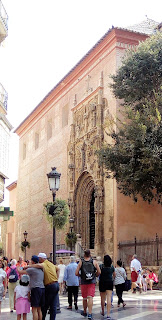Malaga from a different perspective
My well-deserved weekend was spent half on the beach and half on the town exploring some of Malaga's main sights. I started my Sunday by having my very favourite breakfast at the terrace of El Pimpi, one of Malaga's most famous and most traditional restaurants. This breakfast consists of toast with tomato paste and olive oil, a café con leche and a glass of natural orange juice. I have to say that I've had better versions of the tostada con tomate elsewhere, but breakfast is probably not what El Pimpi specializes in. The coffee, however, was good and the location left little to be desired.
El Pimpi's terrace is located just opposite to the oldest historical monument in Malaga, the Roman Theater, built in the 1st century AD and discovered in 1951. For many years, the theater was half-buried under the Casa de Cultura (Cultural Center). In 1995, a decision was made to abolish the Casa de Cultura, and after the excavation works and many years of restoration, the theater was reopened for public in 2011. It is definitely worth the visit for anybody interested in history, and especially beautiful at night time when it's lit.
Right above Roman Theater lies what is perhaps Malaga's most emblematic monument, the Alcazaba palatial fortress that dates back from the city's muslim period. Though not as grand nor a well-known as the Alhambra of Granada, the Alcazaba is said to be the best preserved Moorish fortress palace in Spain.


I had already visited the Roman Theater and the Alcazaba a few weeks back, so it was time for me to head higher and visit another important landmark of Malaga, the Castillo de Gibralfaro (Gibralfaro Castle), originally built to house troops and protect the Alcazaba. After the reconquest of the city, Ferdinand the Catholic made Gibralfaro his temporary residence.
Nowadays, most tourists visit the castle because of the spectacular views of city it offers. If you don't enjoy walking, you can take a bus from the city center. But if you don't mind the exercise, a well-paved way up to the castle leaves from very near the Alcazaba entrance. The walk takes somewhere around 20 to 30 minutes, depending on how many times you want to stop to enjoy the scenery. The climb is pretty steep, but the views are forth it. Once you reach the top, you can walk around the whole perimeter of the fortress and enjoy Malaga from a different perspective. The entrance fee is only 2,20€ - or if you are lucky like me and happen to visit the castle on a Sunday after 2 pm, you don't need to pay anything.
El Pimpi's terrace is located just opposite to the oldest historical monument in Malaga, the Roman Theater, built in the 1st century AD and discovered in 1951. For many years, the theater was half-buried under the Casa de Cultura (Cultural Center). In 1995, a decision was made to abolish the Casa de Cultura, and after the excavation works and many years of restoration, the theater was reopened for public in 2011. It is definitely worth the visit for anybody interested in history, and especially beautiful at night time when it's lit.
Right above Roman Theater lies what is perhaps Malaga's most emblematic monument, the Alcazaba palatial fortress that dates back from the city's muslim period. Though not as grand nor a well-known as the Alhambra of Granada, the Alcazaba is said to be the best preserved Moorish fortress palace in Spain.


I had already visited the Roman Theater and the Alcazaba a few weeks back, so it was time for me to head higher and visit another important landmark of Malaga, the Castillo de Gibralfaro (Gibralfaro Castle), originally built to house troops and protect the Alcazaba. After the reconquest of the city, Ferdinand the Catholic made Gibralfaro his temporary residence.
Nowadays, most tourists visit the castle because of the spectacular views of city it offers. If you don't enjoy walking, you can take a bus from the city center. But if you don't mind the exercise, a well-paved way up to the castle leaves from very near the Alcazaba entrance. The walk takes somewhere around 20 to 30 minutes, depending on how many times you want to stop to enjoy the scenery. The climb is pretty steep, but the views are forth it. Once you reach the top, you can walk around the whole perimeter of the fortress and enjoy Malaga from a different perspective. The entrance fee is only 2,20€ - or if you are lucky like me and happen to visit the castle on a Sunday after 2 pm, you don't need to pay anything.







Comments
Post a Comment